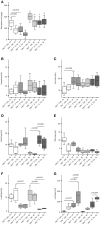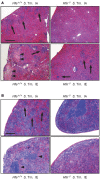Genetic and Dietary Iron Overload Differentially Affect the Course of Salmonella Typhimurium Infection
- PMID: 28443246
- PMCID: PMC5387078
- DOI: 10.3389/fcimb.2017.00110
Genetic and Dietary Iron Overload Differentially Affect the Course of Salmonella Typhimurium Infection
Abstract
Genetic and dietary forms of iron overload have distinctive clinical and pathophysiological features. HFE-associated hereditary hemochromatosis is characterized by overwhelming intestinal iron absorption, parenchymal iron deposition, and macrophage iron depletion. In contrast, excessive dietary iron intake results in iron deposition in macrophages. However, the functional consequences of genetic and dietary iron overload for the control of microbes are incompletely understood. Using Hfe+/+ and Hfe-/- mice in combination with oral iron overload in a model of Salmonella enterica serovar Typhimurium infection, we found animals of either genotype to induce hepcidin antimicrobial peptide expression and hypoferremia following systemic infection in an Hfe-independent manner. As predicted, Hfe-/- mice, a model of hereditary hemochromatosis, displayed reduced spleen iron content, which translated into improved control of Salmonella replication. Salmonella adapted to the iron-poor microenvironment in the spleens of Hfe-/- mice by inducing the expression of its siderophore iron-uptake machinery. Dietary iron loading resulted in higher bacterial numbers in both WT and Hfe-/- mice, although Hfe deficiency still resulted in better pathogen control and improved survival. This suggests that Hfe deficiency may exert protective effects in addition to the control of iron availability for intracellular bacteria. Our data show that a dynamic adaptation of iron metabolism in both immune cells and microbes shapes the host-pathogen interaction in the setting of systemic Salmonella infection. Moreover, Hfe-associated iron overload and dietary iron excess result in different outcomes in infection, indicating that tissue and cellular iron distribution determines the susceptibility to infection with specific pathogens.
Keywords: Salmonella; hepcidin; infection; iron; lipocalin; macrophage; siderophore.
Figures







Similar articles
-
Cell-specific expression of Hfe determines the outcome of Salmonella enterica serovar Typhimurium infection in mice.Haematologica. 2021 Dec 1;106(12):3149-3161. doi: 10.3324/haematol.2019.241745. Haematologica. 2021. PMID: 33054105 Free PMC article.
-
Absence of functional Hfe protects mice from invasive Salmonella enterica serovar Typhimurium infection via induction of lipocalin-2.Blood. 2009 Oct 22;114(17):3642-51. doi: 10.1182/blood-2009-05-223354. Epub 2009 Aug 21. Blood. 2009. PMID: 19700664 Free PMC article.
-
Hfe and Hjv exhibit overlapping functions for iron signaling to hepcidin.J Mol Med (Berl). 2015 May;93(5):489-98. doi: 10.1007/s00109-015-1253-7. Epub 2015 Jan 23. J Mol Med (Berl). 2015. PMID: 25609138
-
[HFE hemochromatosis: pathogenic and diagnostic approach].Transfus Clin Biol. 2005 Jun;12(2):77-82. doi: 10.1016/j.tracli.2005.04.040. Transfus Clin Biol. 2005. PMID: 15925529 Review. French.
-
[Non-HFE-related hereditary iron overload].Presse Med. 2007 Sep;36(9 Pt 2):1279-91. doi: 10.1016/j.lpm.2007.01.042. Epub 2007 May 30. Presse Med. 2007. PMID: 17540536 Review. French.
Cited by
-
Metabolic reprogramming of Salmonella infected macrophages and its modulation by iron availability and the mTOR pathway.Microb Cell. 2019 Nov 14;6(12):531-543. doi: 10.15698/mic2019.12.700. Microb Cell. 2019. PMID: 31832425 Free PMC article.
-
Exploiting haem-iron dependence of nontypeable Haemophilus influenzae: an avenue for future therapeutic development.Front Cell Infect Microbiol. 2025 May 15;15:1548048. doi: 10.3389/fcimb.2025.1548048. eCollection 2025. Front Cell Infect Microbiol. 2025. PMID: 40444152 Free PMC article. Review.
-
Pathogenic potential of non-typhoidal Salmonella serovars isolated from aquatic environments in Mexico.Genes Genomics. 2019 Jul;41(7):767-779. doi: 10.1007/s13258-019-00798-7. Epub 2019 Mar 11. Genes Genomics. 2019. PMID: 30859492
-
Applying whole-genome sequencing in relation to phenotype and outcomes in siblings with cystic fibrosis.Cold Spring Harb Mol Case Stud. 2020 Feb 3;6(1):a004531. doi: 10.1101/mcs.a004531. Print 2020 Feb. Cold Spring Harb Mol Case Stud. 2020. PMID: 32014855 Free PMC article.
-
Iron homeostasis and cytokine responses in Gabonese children with febrile illness.Commun Med (Lond). 2025 Jul 22;5(1):305. doi: 10.1038/s43856-025-00988-3. Commun Med (Lond). 2025. PMID: 40696137 Free PMC article.
References
Publication types
MeSH terms
Substances
Grants and funding
LinkOut - more resources
Full Text Sources
Other Literature Sources
Medical
Research Materials

